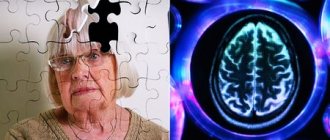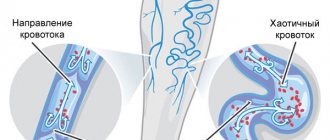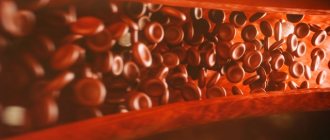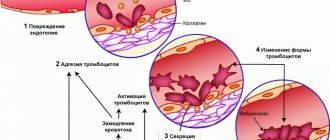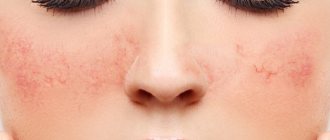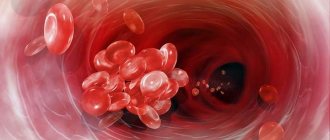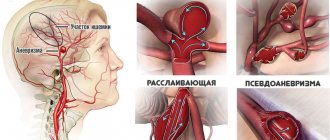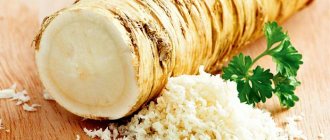The nasal mucosa contains a huge number of capillaries; they perform an important function in heating the air. If these capillaries are fragile or there are blood diseases, or there are other reasons that we will talk about, then these small vessels burst and nosebleeds occur. Therefore, the urgent question is how to strengthen the vessels in the nose so that blood does not bleed.
Most often this phenomenon occurs in children and adolescents. Over the years, the vessels become stronger, but some “lucky ones” remain with this problem for a long time, and many of them do not even attach much importance to this phenomenon and do not take any measures. Meanwhile, the causes of nosebleeds can be life-threatening. Depending on the reason, they choose ways to strengthen the vessels in the nose.
Regardless of the cause of nosebleeds, the mechanism is the same - the integrity of the vessel wall is compromised, and the blood coagulation system is unable to form a strong scab on the surface of the damaged vessel.
Nosebleeds can be anterior or posterior. In the first case, the blood flows directly through the nostril, and in the second, it exits through the nasopharynx.
You can insert a tampon soaked in hydrogen peroxide or simply clamp a large nasal vessel by pressing a point near the wings of the nose. If the vessels are dilated, bleeding can be stopped with vasoconstrictor drops. Sometimes it is enough to use the “cold method” - applying an ice compress to the nose.
In the case of posterior nosebleeds, larger vessels burst, so it is possible to stop the bleeding only in a hospital setting; you cannot do without the help of a doctor. In any case, if the nosebleed does not stop for more than 15 minutes, you must call an ambulance.
Possible causes of nosebleeds
- Injuries to the nasal cavity or craniocerebral, incl. foreign body entry, which can cause capillaries to burst.
- Features of the anatomical structure, when the capillaries are located close to the surface of the nasal cavity or a hereditary predisposition to excessively thin capillaries. In this case, the coagulation method helps - cauterization of capillaries.
- Anomalies and pathologies of blood vessels in atherosclerosis or Marfan syndrome.
- Chronic rhinitis or nasal infections. If you blow your nose too hard, a nearby vessel may burst.
- Neoplasms, incl. polyps in the nose.
- Arterial hypertension, kidney diseases. With high blood pressure, blood from the nose is more of a benefit than a harm; bloodletting sometimes saves you from a stroke. In this regard, doctors use the method of hirudotherapy - bloodletting with the help of blood-sucking medicinal leeches. However, nosebleeds should not last too long.
- In weather-sensitive people with a decrease in atmospheric pressure.
- Blood clotting disorders, taking coagulant-antiplatelet drugs.
- Blood oncology, thrombocytopenic purpura or thin blood, including against the background of low hemoglobin.
- Lack of vitamins C and group B, trace element calcium. Good results are achieved by taking ascorbic acid or the drug Ascorutin, which contains rutin and vitamin C. As is known, with an acute shortage of this vitamin, collagen, necessary for the strength of blood vessels and connective tissues, ceases to be produced. A disease such as scurvy, accompanied by bleeding gums, is also caused by a deficiency of ascorbic acid and is fatal.
- Deviation of the nasal septum, if it is accompanied by frequent runny nose, which, in turn, provoke bleeding. The curvature can only be corrected surgically.
- Dry indoor air is a particularly common cause of broken nasal capillaries in children. Due to the drying out of the air, the top layer of nasal mucus dries out, forming a dry crust, the child tries to pick it off and damages the external small blood vessels. To prevent this, you need to take care of humidifying the air or additionally lubricate the nasal cavity with oil solutions (for example, vitamin A in oil or simple Vaseline). Staying in the fresh air and doing breathing exercises is very beneficial.
- Excessively high physical activity, nervous breakdowns or general overexcitation of the nervous system.
- Overheating of the body.
- Increased levels of female hormones during pregnancy or menstruation in women.
Symptoms indicating the possibility of nosebleeds: constant nasal congestion for no apparent reason, headaches, weakness, loss of consciousness, vomiting.
Drug therapy to stop bleeding, depending on the identified cause, is carried out by taking drugs sodium ethamsylate - Dicion (hemostatic agent), provitamin K (strengthens the effect of Dicynone), calcium chloride, epsilon-aminocaproic acid, calcium dobesylate, vitamin and mineral complexes. In addition to hemostatic drugs, etiological therapy is carried out aimed at eliminating the causes of bleeding.
Cauterization of capillaries
If blood is released from the vessels that are located in the front part of the nasal cavity, the doctor performs coagulation using a special knife. After such manipulation, the mucous membrane does not swell and the person does not feel discomfort.
Laser cauterization of capillaries and large vessels is sometimes accompanied by pain and stuffy nose. The procedure can only be performed by a specialist.
To form a crust and stop bleeding, silver is used during cauterization.
During cryodestruction, the affected vessels are frozen with liquid nitrogen; in case of severe bleeding, they are bandaged, the mucous membrane is excised and removed.
See also
Symptoms and treatment of mucocele of the frontal sinus, possible surgery
Read
What to do to strengthen the blood vessels in the nose?
Provided that serious pathologies, oncology and some other causes that can only be eliminated with medications are excluded, you can independently prevent nosebleeds.
Nasal rinsing
Rinsing with salts, physical or saline isotonic solutions. For a glass of warm water, take half or a quarter teaspoon of salt, sea or regular non-iodized. Saline solution can be prepared at home if you purchase Dolphin or Aqualor. Take a quarter teaspoon of salt per glass of water.
Washing requires a certain discipline, but it is the most cost-effective and effective method. The procedure must be done up to three times a day with a regular 10-cubic syringe, without a needle.
Vitamins
Taking Ascorutin, B vitamins or foods high in them (citrus fruits, rose hips, black currants, sea buckthorn, honeysuckle, kiwi, bell pepper, parsley) or drinks (green tea, cranberry juice). The drug Ascorutin has contraindications.
Hardening
Regular hardening allows you to strengthen and train blood vessels. Hardening does not mean one-time dousing with ice water, but daily procedures, for example, a contrast shower. It will not take much time and can be done regularly. The temperature of the water should be reduced gradually, eventually bringing it to cold, but its effect should be short-lived, after which it should be rubbed vigorously.
Traditional methods: decoctions of nettle or viburnum bark
These herbs are rich in vitamins C and K, which help strengthen the walls of blood vessels. They must be taken in courses and over a long period of time. In addition to these herbs, you can drink tea with St. John's wort, barberry leaves, shepherd's purse or decoctions of oak bark. It is also useful to brew plantain and yarrow leaves or eat crushed chokeberry fruits with sugar.
From Sophora japonica flowers, which contain rutin, you can prepare nasal drops: pour 30g of flower ovary with a glass of boiling water and leave for about half an hour, cool and strain. Drip into each nostril several times a day.
Herbal inhalations
To improve nasal breathing and the condition of blood vessels, it is useful to inhale with the herbs of chamomile, calendula, and sage. In addition to herbal inhalations, inhaling dry salt, which is especially abundant in salt mines, brings good results. This procedure is especially recommended for children and adults with chronic inflammation of the nose - rhinitis, sinusitis. Inhaling sea air also has a healing effect.
Proper nutrition
In addition to the listed foods high in vitamin C, your daily diet should include white and cauliflower, any berries, greens (sorrel, spinach, parsley), and radishes. You can make compotes from berries and rose hips, and eat vegetables fresh in salads.
Immediate help
If a person starts bleeding, he needs to be seated and calmed down, his head tilted forward, not thrown back. When the patient is in the room, a window or window opens. To prevent the patient from fainting, a piece of cotton wool moistened with ammonia should be brought to the face.
If there is bleeding from the anterior part of the nose, a tampon with hydrogen peroxide is inserted into the nostril. A clot should form at the site of capillary damage. You can squeeze the vessel between the lip and gum on the blood outlet side. If it is greatly expanded, you need to instill Naphthyzin.
See also
What will an ultrasound of the nasal and paranasal sinuses show in adults and children, indications and cost
Read
If the nose is bruised, ice is applied, then the person is taken to the emergency room to take an x-ray to make sure there is no broken bone or septum. Posterior bleeding is unlikely to be stopped on its own; the patient needs medical attention.
You can cope with the problem by acting on bioactive points, but to do this you need to know where they are. For minor bleeding, it is enough to give the person tea with sugar. Otherwise, the doctor prescribes medications and calcium chloride is injected into a vein. If the cause of the nosebleed is unclear:
- Tests are taken.
- An ultrasound of the neck and head is performed.
- A coagulogram and MRI are performed.
- The liver is being examined.
Sometimes consultation with a hematologist, ENT specialist, surgeon and other specialists is necessary. In the absence of disorders requiring urgent intervention, medications are prescribed to strengthen blood vessels.
Why do capillaries appear on the nose?
If you notice small red threads on your nose that are visible through the epithelium, it means that you have visible capillaries on your nose. What is the reason for this phenomenon?
The main reason for the appearance of red capillaries on the nose is that their functioning is impaired. This is not dangerous in itself, but is an alarm bell indicating some kind of disease. If capillaries have just appeared on the face, it means that the disease is in its initial, still harmless, stage. But its manifestations should not be ignored.
Increased blood pressure on a regular basis;
Changes in the structure of blood vessels with age;
Inflammatory diseases of the skin;
Frequent exposure to the sun;
Severe overheating or hypothermia;
Taking a number of medications;
Pregnancy and other conditions accompanied by hormonal changes in the body;
Diseases of the excretory system, primarily the kidneys;
Bleeding disorders;
Disturbances of venous outflow.
If your close older relatives have visible capillaries on the wings of the nose and other parts of the face, then the risk of encountering this problem for hereditary reasons increases many times over.
Treatment
Skin prone to inflammation and flaking requires daily care. Dermatologists usually recommend lymphatic drainage massage, cryomassage, masks with menthol and vitamins. In summer, creams with photoprotection are recommended, in winter - cryoprotectors (creams with fats or fatty acids). If manifestations of rosacea become noticeable, you need to turn to more serious methods.
Medicines are usually prescribed in addition to hardware therapy. The following medications have proven themselves to be effective:
- Ascorutin;
- Alpha-linoleic acid;
- Pinogen and Alpha tocopherone;
- Gingko biloba.
Your doctor may also recommend special ointments containing seaweed, calendula, or chamomile. These include Alezans Lierak, Tiande, Sensibio, Uriage Roseliane. These products can be found in cosmetic clinics and pharmacies.
Hardware methods
Electrocoagulation is considered an effective way to get rid of dilated vessels. A special needle is brought to the vessel and an electric current is passed through it. Under the influence of the discharge, the damaged capillary is destroyed.
The disadvantage of this method is that it is painful and may cause scars.
Cryodestruction—cauterization of blood vessels with liquid nitrogen—has the same unpleasant consequences. To remove capillaries on the nose, today you can use more gentle methods.
Laser coagulation. Damaged vessels are soldered under the influence of high temperature. After some time, they become part of the connective tissue, and new, healthy pathways for blood circulation are formed nearby.
Sclerotherapy. A special substance (sclerosant) is injected into the affected capillaries. Under its influence, the vessel sticks together and is removed from the bloodstream.
There are three types of this procedure:
- Microsclerosis to remove spider veins.
- Foam-Form sclerosis, when the coagulant is whipped into foam. A similar procedure is indicated to eliminate the effects of rosacea.
- Echosclerosis, carried out under the control of a laser scanner.
For weak vessels in the nose, treatment should be differentiated. This means that each pathology requires its own measures. And it is necessary to influence not only the vascular wall, but also the factors that have become the direct source and mechanism of the disorders.
General recommendations
To strengthen the vessels in the nose, you can use simple general tips. These include the following:
- Complete and fortified nutrition.
- Air conditioning and humidification.
- Hardening and contrast shower.
- Avoid stress and overwork.
Particular importance is given to proper diet. The diet must include plant foods rich in vitamin C and rutin (fresh fruits and vegetables, herbs). Juices, fruit drinks, berry compotes and decoctions (black currant, rose hips) are useful. The ratio of basic nutrients (proteins, fats and carbohydrates) and caloric content correspond to age, gender and physical activity.
First aid
When you have a nosebleed, it is important to know how to provide first aid. Skillfully carried out measures contribute to hemostasis and improvement of the patient’s condition. Among the basic principles of medical care at the prehospital stage, it is worth noting the following:
- Place the victim in a chair with his head slightly tilted forward.
- Insert cotton swabs (gauze pads) moistened with a solution of hydrogen peroxide into the nasal passages.
- Squeeze the wings of the nose.
- Apply cold to the bridge of your nose.
These methods help with anterior bleeding, but rear bleeding requires mandatory medical intervention, since it will not be possible to reach the damaged vessel. A posterior nasal tamponade is required here.
Medicines
Medicines will help improve the condition of the vascular wall. They act on various mechanisms and have several points of application. The following medications can be recommended for nosebleeds:
- Vitamins (Ascorutin).
- Hemostatics (Etamzilat).
- Salt solutions (Otrivin More, Aqua Maris).
- Vegetable oils (rosehip, sea buckthorn).
For frequent respiratory infections, immunostimulants (interferons, Polyoxidonium) are used, and influenza requires antiviral treatment. If another pathology is detected, then there is a need for specific and syndromic therapy.
Operation
Bleeding vessels can be cauterized (vasotomy). This technique is used when conservative treatment is ineffective. The mucous membrane and superficial capillaries are coagulated using silver nitrate, laser or radiosurgery. But after the operation you will still have to undergo a course of therapy aimed at strengthening the vascular wall.
Those who have had blood vessels burst in their nose know how unpleasant it is. And if bleeding is a frequent concern, you must definitely find out its cause. But only a doctor can conduct a full diagnosis and prescribe adequate treatment.
Usually medications are prescribed in addition to hardware treatments. “Ginkgo biloba”, “Ascorutin”, “Pinogen”, “Alpha-linoleic acid”, “Alpha-tocopheron” have proven themselves well. The action of these drugs is aimed at increasing the elasticity of blood vessels and capillaries. The doctor may also prescribe medicinal ointments with chamomile, calendula, and seaweed. These products can be found in pharmacies on the shelves with medicinal cosmetics.
Symptoms of vascular problems
Problems with blood vessels will not keep you waiting if you experience the following symptoms:
- Lately you have been having a very hard time withstanding the hot season.
- Frequent dizziness appeared, and for no particular reason.
- Darkness in the eyes when standing up suddenly or turning the head.
- Aching appears in the joints.
- The extremities—fingers and toes—get cold.
- Motion sickness appeared in transport, which had not been observed before.
- Negative reactions to weather changes, e.g. increased weather sensitivity.
- Frequently changing pressure, sometimes increased, sometimes decreased.
- Sudden rapid heartbeat.
- The appearance of short-term fainting.
If such manifestations are observed, this means you need to urgently consult a specialist doctor for advice. These symptoms indicate poor circulation and that you have weak blood vessels. The main reason for the weakening and fragility of blood vessels is cholesterol deposits on their walls. Under the pressure of cholesterol plaques, blood vessels lose elasticity and become fragile.
Strengthening blood vessels is a long-term process, and once you start it, you need to return to it regularly. It is impossible to heal and cleanse blood vessels in one area of the body; it is necessary to deal with the entire cardiovascular system.
How to get rid of capillaries on the nose
This disease is treated at the initial stage by a dermatologist. He will also be able to guide you if you need the help of another specialist, for example, a therapist or a vascular surgeon.
Treatment includes medication and hardware methods.
The capillary is removed using a directed electrical discharge. The disadvantage of this method is its pain and possible tiny scars and marks at the puncture site with a needle through which a current is passed.
One of the most painless and effective methods. A directed laser beam promotes gluing of the walls of the enlarged capillary, due to which it ceases to be visible through the skin. The phenomenon is irreversible, which means that the capillary network will no longer appear in this place
The principle of action is similar to laser therapy. Removal of capillaries on the nose occurs due to exposure to a directed pulse of light.
Effective only in the initial stages of the disease. The principle of action is the subcutaneous administration of vitamin compounds that improve blood circulation and generally have a beneficial effect on the condition of the walls of capillaries and the tissues surrounding them.
Liquid nitrogen has recently been used less and less in the treatment of dilated capillaries. It is possible to achieve a mostly temporary effect by moisturizing the skin and eliminating stagnation in the blood vessels.
A sclerosant drug is injected into the dilated capillary. Essentially, it treats the damaged vessel, which leads to its return to normal. There are several variations of this procedure aimed at removing spider veins, rosacea or hemanginomas. The doctor must determine the method. Important! Make sure that the clinic has permission and a license to perform sclerotherapy of blood vessels on the face, since unprofessional actions can lead to serious consequences.
